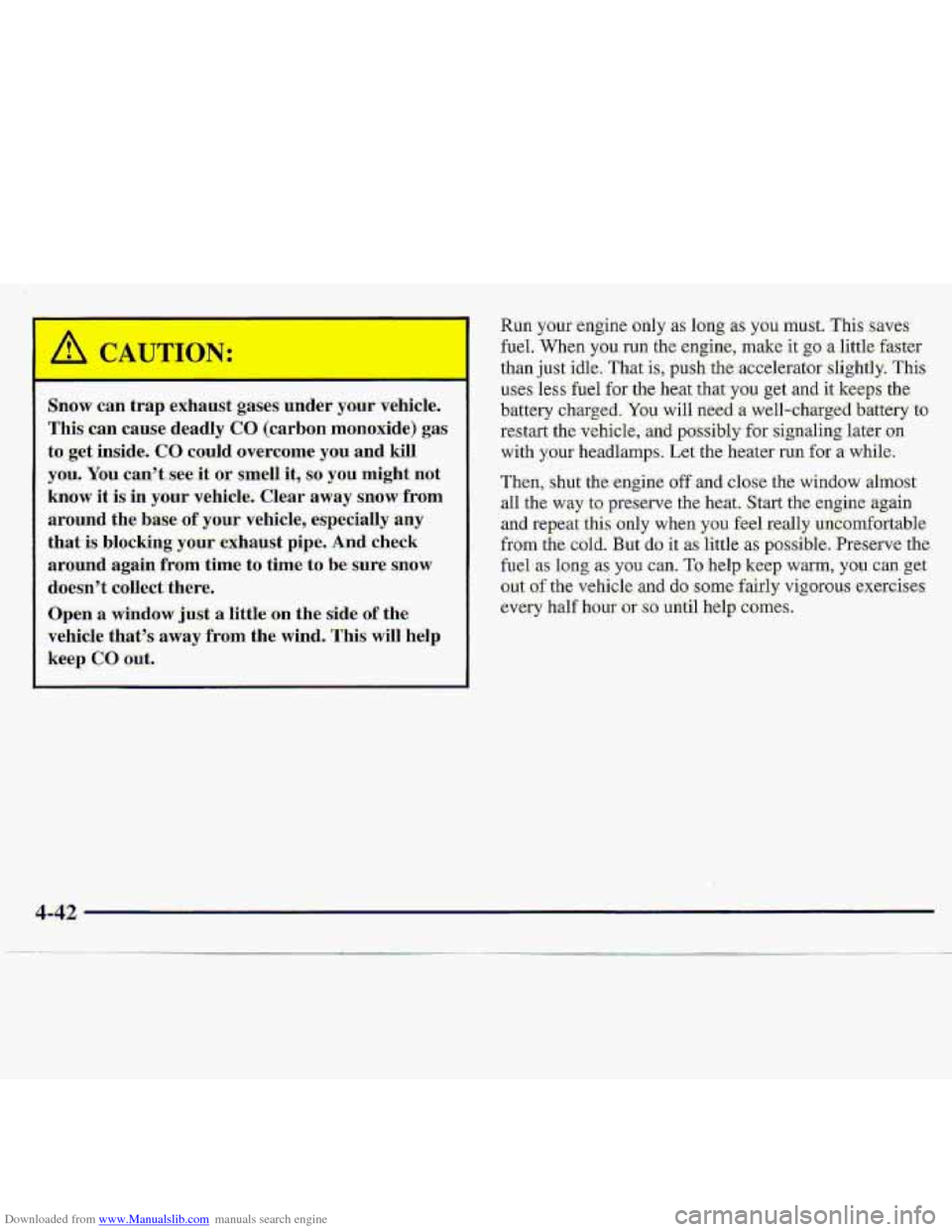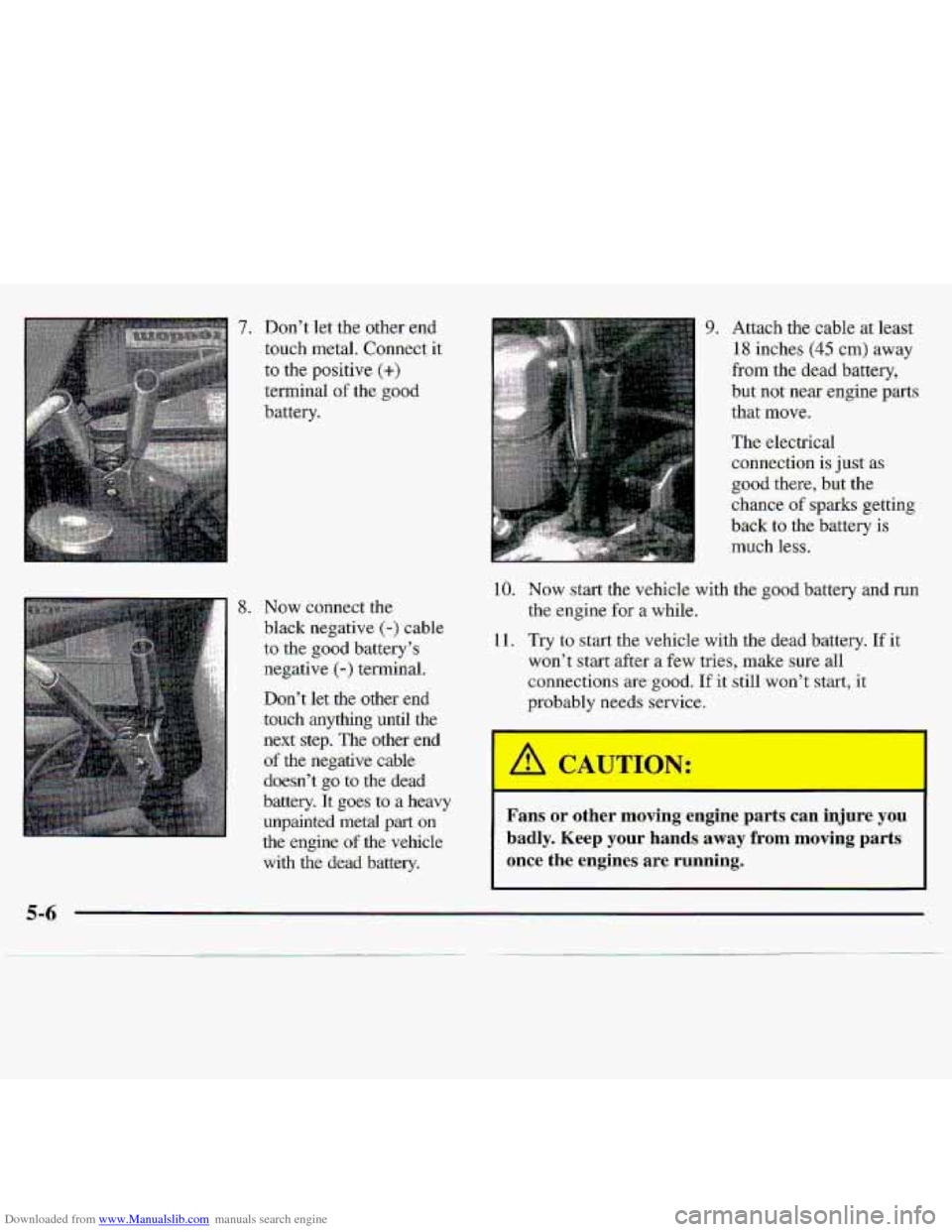Page 179 of 402

Downloaded from www.Manualslib.com manuals search engine Snow can trap exhaust gases under yo.ur vehicle.
This.can cause
deadly CO (carbon rncmoxide) gas
to get: inside. CO could overcome you and kill
you.
'You can't .see it or smell it, so you might not
know it is in your vehicle. Clear away snow from
aruund the. base of your vehicle, especially any
that
is blocking your exhaust pipe. And check
around again
from time to time- to be.sure snow
doesn't col1ect:there.
Open a window just a, little on the side of the
vehicle that% away
froin the wind. This will help
keep
CO out.
Run your engine o111y as long as you h~ust. This s&veS-
fu.eL When you run the engine, make it g.-a little faster
than just idle. That is, push. the, accelerator..slightIy. This
uses less fuel far the heat that .you get and it keeps- the.
battery
charg.ed. You willl neecia well-charged battery 'to
restart the vehicle, and possibly for signaling later an
with. your headamps.. Let the heatex run for a while.
Then,. shut the-engine off and dose the window almost
all the way to' p&erve the heat. Start the e.ngine again
and repe.at
.this only when you feel ceally qxkbmfortable
from the cold. But. do it as little as possible, Preserve the
fuel as- long- as you can. To help keep warm, you can get
out of the vehicle. and do some .faidy vlgorous -exercises
every half how os so until help comes.
Page 202 of 402

Downloaded from www.Manualslib.com manuals search engine 4. Open the hoods and locate the batteries. Find
the positive
(+) and negative (-) terminals on
each battery.
Using a match near .a battery can cause battery
gas to explode. People have been hurt doing this,
and some have been blinded. Use a flashiight
if
you need more light.
Be sure the battery has enough water.
You don’t
need to add water
to the Delco Freedom@ battery
installed
in every new GM vehicle. But if a
battery has filler caps, be sure the right amount
of fluid is there. .If it is‘low, add water to take care
of that fist, If you don’t, explosive gas could
be present.
Battery
fluid contains acid that can burn you.
Don’t get it on you. If you accidentally get it in
your eyes or on your skin, flush the place with
water and get medical help immediately.
5. Check that the jumper cables don’t have loose or
missing insulation.
If they do, you could. get a shock.
The-vehicles could be damaged too.
Before you connect the cables, here are some- basic
things
you should know. Positive (+> will ga
to positive (+) and negative (-) will go to a
metal engine
part. Don’t connect positive (+) to
negative
(-) or you’ll get a short that would damage
the battery and maybe other parts too.
6. Connect the red
positive
(+) cable to the
positive
(+) terminal of
the vehicle with the
dead btittery.
Page 203 of 402

Downloaded from www.Manualslib.com manuals search engine 7. Don’t let the .other.end
touch metal. Connect it-
to the positive
(+)
terminal of the good
battery.
8. Now connect the
black negative
(-1 cable
to the good battery’s
negative
(-> terminal.
Don’t let the other end
touch
anything until the
next step. The other end
of the negative cable
doesn’t
go to the dead
battery.
It goes to.a heavy
unpaiked
ketal part on
the engine .of the vehicle
with the
dead battery.
9. Attach the cable at least
18 inches (45 cm) away
from the dead battery,
but
not near engine parts
that move.
The electrical
connection
is just as
good there, but the
chance
of sparks getting
-back
to the battery is
much less.
10. Now start the vehicle with the good battery and run
the engine for a while.
11. Try to start the vehicle with the dead battery.
If it
won’t start after
a few tries, make sure all
connections are
good. If it still won’t start, it
probably needs service.
Fans or other moving engine parts can injure you
badly. Keep your hands away from moving parts
once the engines .are running.
5-6
Page 204 of 402
Downloaded from www.Manualslib.com manuals search engine 1.2. Remove me cables in reversemder .to prevent
electrical shGrting. Take c.ae that they don’? touch
each .other, or any other metal.
A. Heavy Metal Engine Part
B. Good Battery
C. Dead Battery